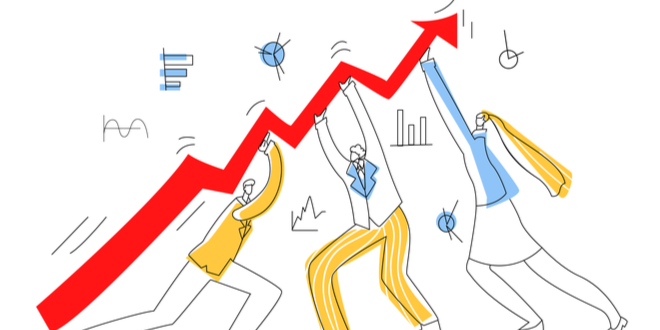One question hangs over the U.S. economy as 2023 gets underway: will there be a recession during the next 12 months, or will the economy grow and continue to add jobs?
The answer to that inquiry rests almost entirely with the Federal Reserve, and to what extent it raises interest rates during the next 12 months, according to Chris Thornberg, director of the UC Riverside Center for Economic Forecasting and Development.
Thornberg, who has been bullish on the U.S. economy in the past when other economists were predicting a sustained economic slowdown, addressed the issue in October at the forecasting center’s annual economic conference.
Thornberg acknowledged “signs of stress” in some sectors of the economy. But, he added, the stimuli implemented by the Trump and Biden administrations during the pandemic will continue to keep consumer spending up this year, and that will keep the economy moving forward.
“The only possible thing that could tip things downward in the near-term is if the Fed applies even more aggressive quantitative tightening to control inflation than they’re now projecting,” Thornberg said.
On Feb. 1, the Federal Reserve is expected to raise interest rates by 0.25 percent to reduce inflation, but it could go for a 0.5 percent hike, according to Forbes.
After that, the Fed is expected to meet eight times this year to discuss possible interest rate hikes. The consumer price index did fall from nine percent to seven percent between June and November of last year, but that drop was considered “insufficient,” the magazine reported.
Locally, the Inland economy should enjoy a solid 2023. If it does as well as it did in 2022 it won’t have much to complain about.
Last year, Riverside and San Bernardino counties outperformed other major metro markets in California, according to a second study by the UCR forecasting center.
That strong performance during the past 12 months all but completed the region’s recovery from the pandemic, starting with its labor force, the forecasting center reported.
Riverside and San Bernardino counties have more than recovered the 228,700 jobs that were lost because of COVID-19 shutdowns. Since April of 2020, the Inland economy has added more than 316,000 jobs, outdoing both California and the nation.
The Inland Empire labor force – meaning any resident who is willing and able to work – grew during COVID-19.
From February 2020 to October 2022, the labor force in Riverside and San Bernardino counties increased by 75,800 workers, an increase of 3.6 percent during those 32 months. During that time, California’s labor force lost 256,900 workers, a 1.3 percent decline.
The study also noted that:
- Inflation may have peaked, but that doesn’t mean prices will start dropping anytime soon. Consumers should expect the cost of goods and interest rates to remain high, at least for a while;
- “Move-up” housing purchases are almost non-existent, mostly because of low mortgage rates that people aren’t willing to give up, and there is considerable equity in the U.S. housing market that has built up over the last 10 years;
- The Inland Empire has five percent more jobs now than it had before the pandemic. By comparison, Ventura County’s job counts dropped three percent during that time. Both trends are a reflection of California’s “uneven” post-COVID jobs recovery;
- Inland Empire employment will grow in 2023, but probably at a slower pace than in the previous year. The report also noted that 16.6 percent of the region’s jobs are in transportation and logistics.
Inland employers probably will add jobs in 2023, but predicting how the overall economy will perform is anyone’s guess, one local economist said last week.
“If the Federal Reserve overreaches and raises interest rates too high, then a recession of some degree is almost guaranteed,” said Jay Prag, professor of economics at the Drucker School of Management at Claremont Graduate University. “If not, there probably won’t be one.
“That’s the short answer,” Prag continued. “Maybe the real answer is no one knows what is going to happen with the economy in 2023. But I’m afraid it’s going to be a rocky road.”
Inflation, by far the biggest issue facing the U.S. economy at the moment, was at 7.1 percent for the 12-month period that ended in November, a drop of 0.6 percent year-over-year, according to the U.S. Department of Labor.
Some of that drop can be attributed to the Federal Reserve’s rising interest rates, but 7.1 percent is still way above the two percent that most economists, and the Fed, consider acceptable, according to Prag.
“Inflation affects everyone, and it’s very difficult to fix,” Prag said. “It’s a lot harder than just having to get people back to work.”
But interest rate hikes don’t necessarily mean a recession will happen, said Robert Kleinhenz, an economics consultant based in Long Beach.
“The rate hikes the FED is talking about now will be enough to keep the economy going,” Kleinhenz said. “As long as they don’t tighten too much there won’t be a problem.”
In the Inland Empire, the logistics industry will continue to be strong this year, but perhaps not as strong as it has been in the past few years, according to Prag.
“We get a lot of imports from China, and China’s economy is struggling right now,” Prag said. “That could hurt logistics everywhere, not just the United States, and I don’t think we’ll get any help from Washington. There’s too much disarray there.”
Another major part of the Inland economy – trade and tourism – could also take a hit this year.
“There’s going to be a ‘wait-and-see approach to the economy, in terms of overall activity, and I think that will cause some people to curtail their major travel plans,” said Prag, who predicts an unemployment rate of four to 4.5 percent for the Inland Empire this year. “Last year, there was a lot of pent-up demand for travel because of COVID, but I think that’s done. So tourism and hospitality should be down from last year.”
Both the national and Inland economies are still dealing with the fallout from COVID-19, which includes the Federal Reserve undoing much of what it put in place to keep the economy from collapsing during that crisis.
“Economic policies are modeled on things that happened in the past, but we can’t do that here,” Prag said. “Nothing like COVID-19 has ever happened before. It’s a very difficult thing to deal with.”
 IE Business Daily Business news for the Inland Empire.
IE Business Daily Business news for the Inland Empire.


